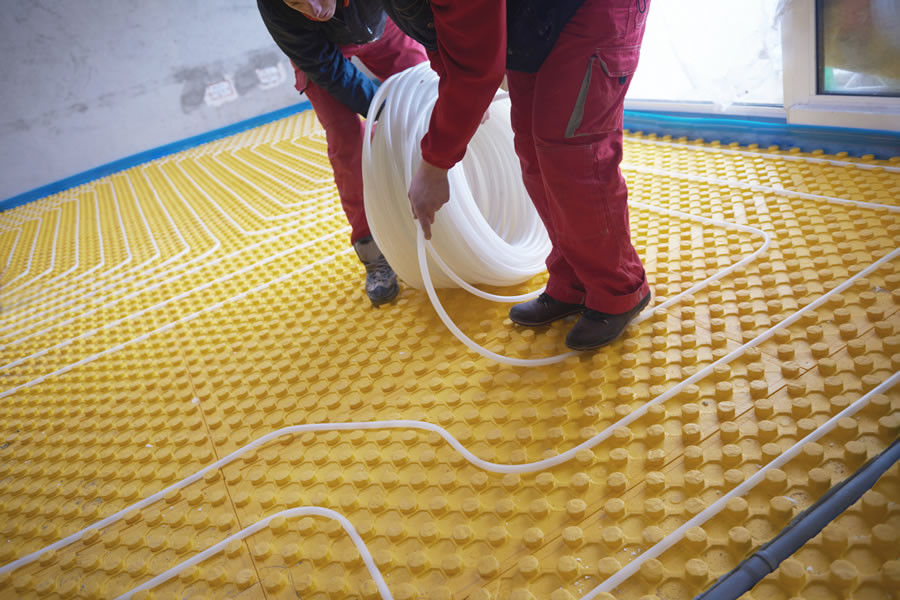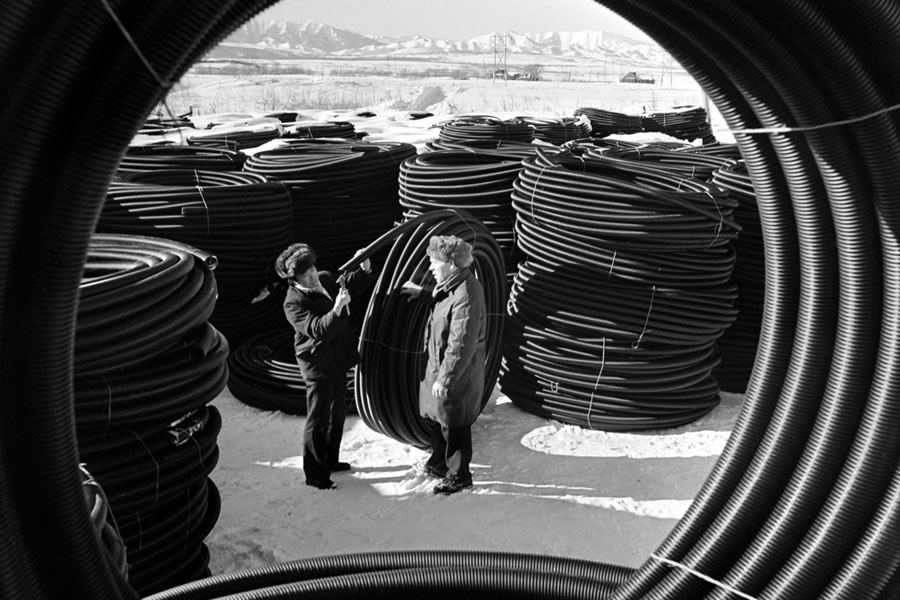The unique properties of cross-linked polyethylene (PEX) enable it to compete with polypropylene as a pipe material. It is highly tolerant of temperature and pressure swings, and shows supreme resistance to cold and plasticity. However, PEX pipes are quite expensive and have low repairability. In spite of that, they have secured their position in the market and continue to gain traction.
Primarily used as a material for PEX pipes, cross-linked polyethylene competes in this segment with PE-RT and polypropylene. While they have been evolving almost in parallel and share many similarities, PP and PEX are also different in many ways which shows in their applications.
Explaining PEX
Just as the non-cross-linked version, cross-linked polyethylene (PEX) consists of long chains of ethylene molecules. But what sets it apart is cross-linked bonds that exist between PEX molecules and convey additional qualities to the product.
Although at present РЕХ pipes cannot effectively compete with their PP counterparts, it seems to be only a matter of time before it happens.
PEX comes in a number of varieties, each having its own cross-linking type.
In PEX A, molecules are linked using peroxides providing for the highest cross-linking degree of up to 85%. Thanks to their supreme elasticity and flexibility, PEX A pipes can be easily restored to their original shape with a heat gun. Despite its slightly lower pressure tolerance compared to РЕХ В, this is the most expensive grade.
In РЕХ В, the most popular one, molecules are linked using silanes (silicone hydrides), with cross-linking as high as 70%. While РЕХ В pipes boast the highest pressure tolerance, their cross-linking structure is somewhat heterogeneous, which results in a lower flexibility compared to PEX A and makes couplings the only solution in case of shape distortions.
In PEX C, the cheapest variety, molecules are linked using radiation rather than chemicals, which enables cross-linking of 60%. PEX C is similar to РЕХ В, except that no chemical additives are used to achieve better performance. It also has the highest risk of microcracking among all three varieties (there is also a nitrogen cross-linked D-type, but it is too complex to produce and almost non-existent).
PEX and PP have similar thermal conductivity (0.3–0.4 W/(m⋅K) and 0.24 W/(m⋅K), respectively) and melting points (200°C and 160–170°C, respectively). Both boast strong durability and almost identical elongation at break (up to 800%). However, PEX has superior cold resistance (it can sustain temperatures as low as -50°C, while PP's threshold is a mere -15°C) and much better flexibility (the minimum bend radius for a PEX pipe is 5D or 3D when using a spring, while for a PP one it is 8D). While PP shows higher stress cracking resistance than PEX under constant load, during load swings the situation is opposite. Maximum operating temperature for both materials is 90°C, although high temperatures will make PP’s useful life shorter. A PEX product may be in use for up to 50 years if the heat transfer medium’s temperature is 75°C or less, but high pressures and temperatures above 90°C will reduce its life to 15 years.
PEX pipes can be used to speed up installation of heating in new buildings, including underfloor systems. Thanks to their plasticity, they can be supplied in reels for smoother logistics, require no welding and much less fittings – junction pieces used in construction to change the direction of metal and other pipelines. Fittings for PEX pipes significantly differ from those for other pipes, being a sort of clamps that use pressure to hold parts together. The main disadvantage of modern PEX pipes is their price, which is on average four times higher than for PP. Undoubtedly, this will stall their advance in the near future. Besides, PEX pipes are not the best replacement for metal ones as they require an entirely different pipework layout that needs to be designed prior to construction and is usually unchangeable.
“Unlike other materials, PEX is incapable of deformation at high temperatures (zero thermoplasticity),” says Andrey Yakimov, Key Account Manager at SIBUR’s Basic Polymers Division. “It can take a specific shape only once, with no possibility of reuse.” “PEX pipes have low repairability,” notes Aleksey Klepikov, Senior Product Marketing Expert at SIBUR’s Basic Polymers Division. “In the case of a PP pipe, one can easily cut off a damaged segment and weld on a new one, while a PEX pipe would need to be replaced entirely, hence increased costs.” Most market participants consider large-scale production of PEX for pipes quite risky as a lot of pipe manufacturers breach the technology by skipping the temperature processing stage. As a result, the product becomes prone to cracking while in use, which negatively affects customer experience. Furthermore, the process of manufacturing a PEX pipe is four times longer than for a PP pipe. Although at present РЕХ pipes cannot effectively compete with their PP counterparts, it seems to be only a matter of time before it happens. “ZapSibNeftekhim’s focus in that area will be on the third, most advanced generation of random copolymers for high-quality PP pipes,” says Yakimov. “At the same time, SIBUR is considering PEX B production at its new facility.”
PEX pipes are often used for a speedier installation of heating in new buildings, including underfloor systems.
“Unlike other materials, PEX is incapable of deformation at high temperatures (zero thermoplasticity),” says Andrey Yakimov, Key Account Manager at SIBUR’s Basic Polymers Division. “It can take a specific shape only once, with no possibility of reuse.”
PEX pipes can be used to speed up installation of heating in new buildings, including underfloor systems. They require no welding and much less junction pieces.
“PEX pipes have low repairability,” notes Aleksey Klepikov, Senior Product Marketing Expert at SIBUR’s Basic Polymers Division. “In the case of a PP pipe, one can easily cut off a damaged segment and weld on a new one, while a PEX pipe would need to be replaced entirely, hence increased costs.”
Most market participants consider large-scale production of PEX for pipes quite risky as a lot of pipe manufacturers breach the technology by skipping the temperature processing stage. As a result, the product becomes prone to cracking while in use, which negatively affects customer experience.
Furthermore, the process of manufacturing a PEX pipe is four times longer than for a PP pipe. Although at present РЕХ pipes cannot effectively compete with their PP counterparts, it seems to be only a matter of time before it happens.
“ZapSibNeftekhim’s focus in that area will be on the third, most advanced generation of random copolymers for high-quality PP pipes,” says Yakimov. “At the same time, SIBUR is considering PEX B production at its new facility.”
Polymeric pipes in retrospective
Unlike other materials, PEX is incapable of deformation at high temperatures (zero thermoplasticity).
The first polymeric pipes were manufactured in the 1930s in the USA. Due to a limited diameter, those PVC products were used only in low-rises. Towards 1950s, a marked shortage of metal pipes set the stage for polyethylene alternatives, although they proved to be short-lived. Having virtually no resistance to high temperatures, those pipes cracked and became useless at a mere 50°C.
In 1958, Italy and the USA started manufacturing PP pipes which enjoyed strong demand due to better resistance to high temperatures and improved safety.
In 1978, Thomas Engel, a Swedish engineer, came up with a technology to make cross-linked HDPE, and PEX paved the way for a comeback of polyethylene pipes.
Production of polymer pipes dates back to the Soviet time.
Meanwhile, production techniques for PP pipes also improved and adapted to new performance requirements. In 1979, German and English manufacturers introduced upgraded composite products, and 1997 saw the emergence of reinforced PP – again, in Germany.
As a result, polymeric pipes took a significant market share from metal ones, which are inferior to PP and PEX counterparts in terms of performance (they are prone to corrosion, heavier, burst when water freezes inside, have higher thermal conductivity, etc.). Nowadays, metal pipes become increasingly less popular.
Download PDF









EUR 1.2 m
average cost of a PEX pipe production line